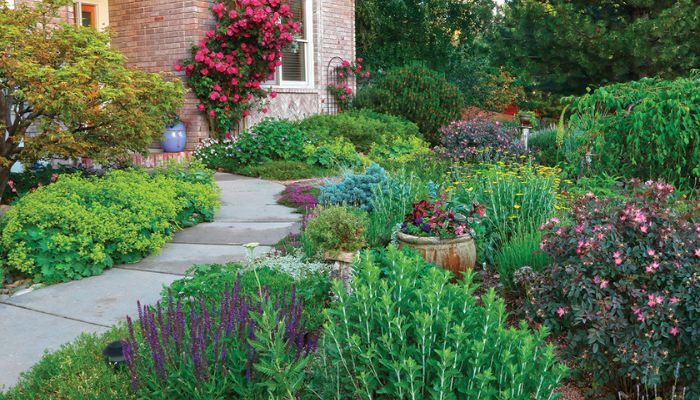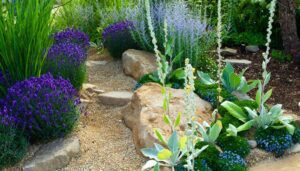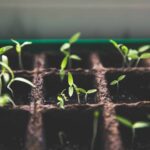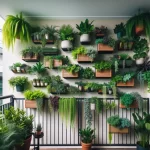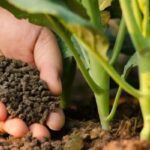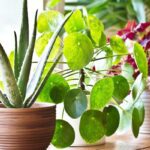As a professional landscape designer with over 7 years of experience, I have designed dozens of stunning yet water-wise gardens. With climate change and droughts becoming more common, it’s crucial now more than ever to incorporate water conservation into your garden. Here we will explore “What Are the Best Tips for Designing a Water-Wise Garden?”
After years of research and first-hand experience, I’ve discovered the best practices for crafting gardens that require less water yet still thrive with lush beauty. In this article, I will share the most effective tips I’ve learned for making water-wise garden design choices.
Choose Native, Drought-Resistant Plants
The foundation of any water-wise garden starts with the choice of plants. Select plants native to your hardiness zone, as natives require far less water than exotic varieties. I always reference the EPA’s WaterSense program for the best native plants for dry regions.
For example, in my coastal Southern California gardens, I choose natives like Cleveland Sage, California Lilac, and Manzanita. These plants have adapted to thrive in hot, dry environments and need little to no irrigation once established.
I also ensure at least 50% of the plants in my water-wise gardens are labeled drought-tolerant. From experience, Sea Lavender, Red Hot Poker, and Sunset Hyssop are excellent choices that withstand drought with minimal water needs.
Group Plants by Water Needs
Rather than intermixing plants with varying water needs, I designate separate zones in my water-wise garden designs based on irrigation requirements.
For instance, I cluster all the drought-resistant native plants together in the zone farthest from the house. These hardy plants need only minimal water once established. Then, I place ornamentals and edibles that require moderate water closer to easy-access irrigation near the home. Thoughtful zoning saves significant water compared to general broadcast irrigation.
Add Lots of Organic Mulch
In all my dry climate gardens, I apply at least 3-4 inches of organic mulch over the soil, whether bark, compost, leaves, or wood chips. The mulch acts as a blanket, retaining soil moisture and preventing evaporation.
I advise using shredded bark fines, one of the best mulches for water retention in my experience. The small shred size packs tightly. After mulching my gardens, I find I can reduce watering frequency by about 30%.
Install Drip Irrigation
For most homeowners, it can be challenging to fully transition a traditional garden into a water-wise landscape without some supplemental irrigation.
From experience, I know drip irrigation delivers water far more efficiently than sprinklers. Drip systems apply water directly to plant roots via emitters and tubing, rather than spraying water into the air where over 50% is lost to evaporation.
I recommend a smart drip system with a WiFi controller. The controllers I install allow homeowners to set schedules, make adjustments remotely, and receive usage reports through a phone app. Smart technology takes the guesswork out of efficient watering.
Include Rainwater Catchment
While drip irrigation already conserves water, I take advantage of natural precipitation as well in my water-wise gardens. Installing rain barrels or cisterns to catch roof runoff provides a free source of irrigation water.
Depending on your region’s rainfall, harvested rainwater can supply over 50% of your garden’s irrigation needs. I use rain catchment systems in conjunction with drip irrigation to significantly cut reliance on municipal water. During wet seasons, the rainwater may be adequate on its own to sustain the garden.
Add Water-Wise Garden Features
Beyond plants and irrigation, I incorporate design features into my gardens to conserve even more water.
For example, I install permeable hardscapes like gravel and stone pathways to allow rainwater to filter into the soil rather than run off the property. In patio areas, I construct shade structures covered with solar panels. The structures cool the garden, reducing evaporation, while the panels generate sustainable electricity.
I also design my gardens to harvest air moisture. Curving gravel beds channel breezes, driving air movement through the garden. Placing hygroscopic plants like aeoniums and lavender near heat-reflecting surfaces prompts condensation absorption.
Every detail matters when sculpting an efficient, water-conserving landscape.
Allow Your Garden to Go Dormant
Some homeowners stress when their native plants turn brown during the summer dry months. But dormancy is natural for many drought-adapted species as a survival mechanism for intense heat and aridity.
I advise clients not to panic over dormant gardens, as the plants will perk up once cooler rainy weather returns in fall. Watering dormant plants wastes money and resources. Allow your native, drought-resistant choices to rest; trust they will revive.
Consider Hydrozoning Restrictions
If you live in a region facing extreme drought, local authorities may impose mandatory hydrozoning landscaping restrictions. These require zoning gardens into low, moderate, and high water use areas.
I follow all hydrozoning protocols in my garden designs, as the principles align perfectly with water-wise techniques. Typically, hydrozoning mandates that turf grass can account for no more than 25% of the landscaped area, while native plants must comprise over 50%. Local plant lists provide guidance on qualifying low water species.
Adhering to hydrozoning guidelines guarantees sustainable, compliant gardens that help communities conserve during droughts.
Consult With Water Management Agencies
To craft the most effective water-saving gardens, I consult municipal water suppliers for further region-specific tips. Agencies like the California State Water Resources Control Board provide interactive maps showing state-wide drought conditions.
I reference these tools to target my garden designs to current realities. For example, removing turf and restricting watering days may be critical needs in extreme drought regions. Water agencies also supply listings of ideal plants and practical conservation methods for each locale.
Some municipalities offer landscape design rebates if you meet set water reduction targets. I take advantage of these programs to pass added savings to my clients. Connecting with local water experts ensures I can continue enhancing garden water efficiency.
Embrace Limitations as Design Inspiration
Some perceive water restrictions as an obstacle that stifles creativity. I view them as opportunities. Constraints inspire innovation.
While xeriscaping with rocks and cacti may seem the only drought-tolerant option, this is far from true. Even with limitations, I relish the challenge of building gorgeous gardens merging water-thrifty native plants with striking textures and colors.
Take inspiration from nature, where plants have adapted through intriguing mechanisms to manage arid environments. With mindful plant choices and water budgeting techniques, you can design a sustainably lush garden that thrives within water limits.
The future of landscaping lies in water-wise gardening. As climate change progresses, designing gardens suited for dry conditions will only gain importance. I take pride in guiding clients toward responsible, eco-friendly landscapes adapted for success in any environment.
Conclusion
With some creative vision and these practical tips, you too can craft a soul-stirring garden that flourishes beautifully on less water. The plants will thrive, your community will benefit, and you may even save money on utilities. A water-saving garden offers rewards across the board – join me in embracing the challenge today! I hope you get all the tips on “What Are the Best Tips for Designing a Water-Wise Garden?”.

Katia Hougaard is a PhD candidate at Imperial College London, specializing in plant-aphid interactions. With a background in Plant Biology from the University of Texas at Austin, she focuses on the genetic and physiological resistance of Medicago truncatula to pea aphids. Katia has served as a science advisor for startups in vertical farming and the houseplant industry. She also mentors students and manages a research lab, contributing her expertise to both academic and entrepreneurial projects. At SuperbPlants.com, Katia shares her in-depth knowledge of plant biology, emphasizing sustainable practices and scientific integrity.

